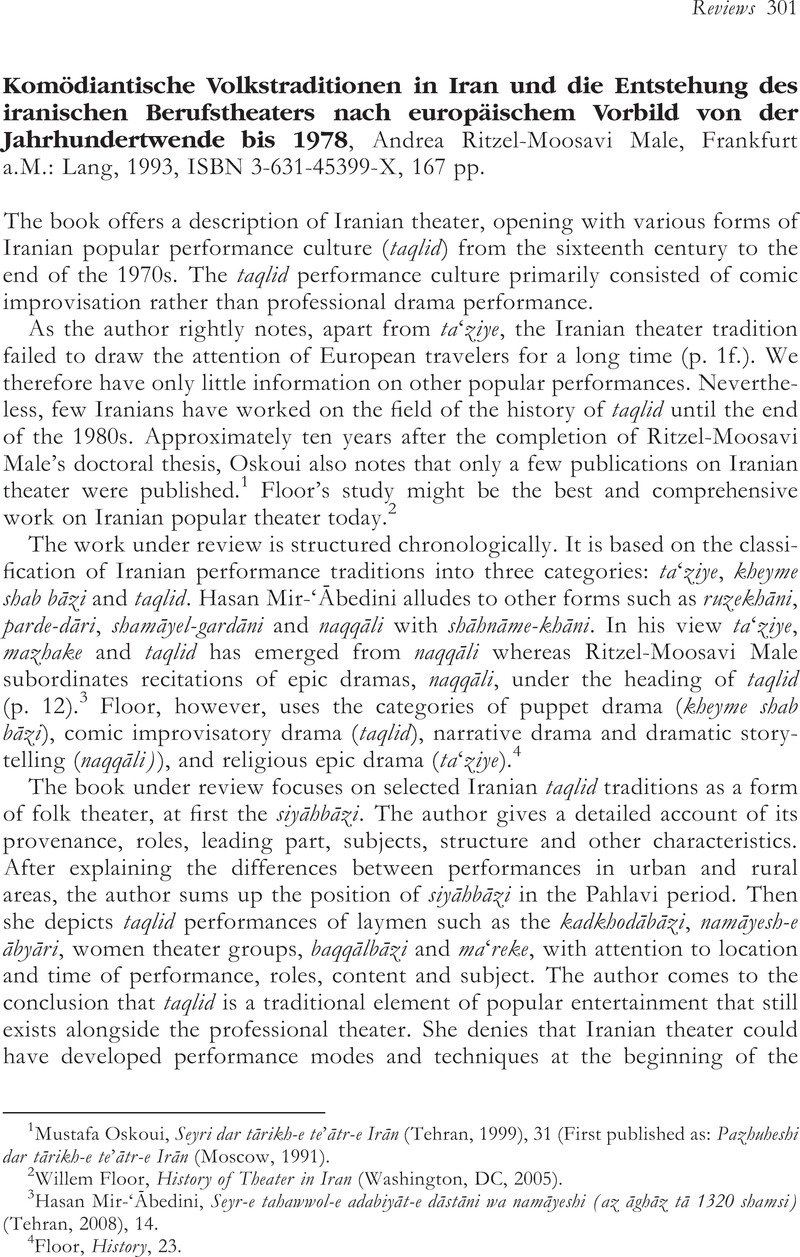No CrossRef data available.
Article contents
Komödiantische Volkstraditionen in Iran und die Entstehung des iranischen Berufstheaters nach europäischem Vorbild von der Jahrhundertwende bis 1978, Andrea Ritzel-Moosavi Male, Frankfurt a.M.: Lang, 1993, ISBN 3-631-45399-X, 167 pp.
Review products
Published online by Cambridge University Press: 01 January 2022
Abstract

- Type
- Reviews
- Information
- Copyright
- Copyright © Katja Föllmer 2010
References
1 Oskoui, Mustafa, Seyri dar tārikh-e te’ātr-e Irān (Tehran, 1999), 31Google Scholar (First published as: Pazhuheshi dar tārikh-e te’ātr-e Irān (Moscow, 1991).Google Scholar
2 Floor, Willem, History of Theater in Iran (Washington, DC, 2005).Google Scholar
3 Mir-‘Ābedini, Hasan, Seyr-e tahawwol-e adabiyāt-e dāstāni wa namāyeshi (az āghāz tā 1320 shamsi) (Tehran, 2008), 14.Google Scholar
4 Floor, History, 23.
5 Halabi, ‘Ali Asghar, Tārikh-e tanz wa shukhtab‘i dar Irān wa jahān-e eslāmi tā ruzegār-e ‘Obeyd-e Zākāni (Tehran, 1998)Google Scholar, in particular 178–340.
6 Rezvani, M., Le théâtre et la danse en Iran (Paris, 1962)Google Scholar; Chelkowski, Peter J., ed., Ta‘ziyeh, Ritual and Drama in Iran (New York, 1979)Google Scholar; Oskoui, Seyri.
7 For further information on theater in the Islamic Republic of Iran see Floor, History, 297–304.
8 Beeman, William O., “Cultural Dimensions of Performance Conventions in Iranian Ta‘yizeh,” in Ta‘ziyeh, Ritual and Drama in Iran, ed. by Chelkowski, Peter (New York, 1979), 24–31.Google Scholar
9 Parviz Mamnoun, “Ta‘ziye from the Viewpoint of the Western Theater,” in Ta‘ziyeh. Ritual and Drama in Iran, ed. by Chelkowski, 154–166.
10 For a systematic analysis of Iranian traditional performances, see Mahdavi, Shireen, “Amusements in Qajar Iran,” Iranian Studies, 40, no. 4 (2007): 483–499.CrossRefGoogle Scholar
11 Compare Gluck, Robert, “The Shiraz Arts Festival: Western Avant-Garde Arts in the 1970s Iran,” Leonardo, Journal of the International Society for the Arts, Sciences and Technology, 40, no. 1 (2007): 20–28.Google Scholar


